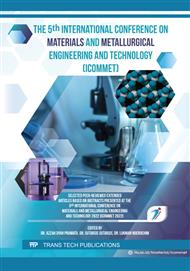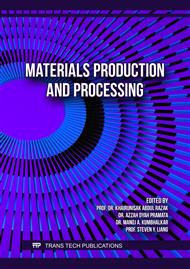[1]
A. Saravanan, P. Senthil Kumar, S. Jeevanantham, S. Karishma, and D. V. N. Vo, "Recent advances and sustainable development of biofuels production from lignocellulosic biomass," Bioresour. Technol., vol. 344, no. PB, p.126203, 2022.
DOI: 10.1016/j.biortech.2021.126203
Google Scholar
[2]
S. Cattaneo, M. Stucchi, A. Villa, and L. Prati, "Gold Catalysts for the Selective Oxidation of Biomass-Derived Products," ChemCatChem, vol. 11, no. 1. Wiley Blackwell, p.309–323, Jan. 09, 2019.
DOI: 10.1002/cctc.201801243
Google Scholar
[3]
B. Y. Song, Y. He, Y. L. He, D. Huang, and Y. W. Zhang, "Experimental study on anode components optimization for direct glucose fuel cells," Energy, vol. 176, p.15–22, 2019.
DOI: 10.1016/j.energy.2019.03.169
Google Scholar
[4]
S. Zhang, Z. Liu, W. Yan, Z. Guo, and M. Ruan, "Decorating non-noble metal plasmonic Al on a TiO2/Cu2O photoanode to boost performance in photoelectrochemical water splitting," Chinese J. Catal., vol.41, no. 12, p.1884–1893, 2020.
DOI: 10.1016/S1872-2067(20)63637-3
Google Scholar
[5]
A. Speltini et al., "Improved photocatalytic H2 production assisted by aqueous glucose biomass by oxidized g-C3N4," Int. J. Hydrogen Energy, vol. 43, no. 32, p.14925–14933, 2018.
DOI: 10.1016/j.ijhydene.2018.06.103
Google Scholar
[6]
H. Miyabe and S. Kohtani, "Photocatalytic single electron transfer reactions on TiO2 semiconductor," Sci. China Chem., vol. 62, no. 11, p.1439–1449, 2019.
DOI: 10.1007/s11426-019-9626-9
Google Scholar
[7]
C. H. Lu, G. V. Biesold-Mcgee, Y. Liu, Z. Kang, and Z. Lin, "Doping and ion substitution in colloidal metal halide perovskite nanocrystals," Chem. Soc. Rev., vol. 49, no. 14, p.4953–5007, 2020.
DOI: 10.1039/c9cs00790c
Google Scholar
[8]
H. Yuan, Y. Zhao, J. Duan, Y. Wang, X. Yang, and Q. Tang, "All-inorganic CsPbBr3 perovskite solar cell with 10.26% efficiency by spectra engineering," J. Mater. Chem. A, vol. 6, no. 47, p.24324–24329, 2018.
DOI: 10.1039/c8ta08900k
Google Scholar
[9]
Y. Wei, Z. Cheng, and J. Lin, "An overview on enhancing the stability of lead halide perovskite quantum dots and their applications in phosphor-converted LEDs," Chem. Soc. Rev., vol. 48, no. 1, p.310–350, 2019.
DOI: 10.1039/c8cs00740c
Google Scholar
[10]
M. Singh and I. Sinha, "Halide perovskite-based photocatalysis systems for solar-driven fuel generation," Sol. Energy, vol. 208, no. July, p.296–311, 2020.
DOI: 10.1016/j.solener.2020.08.007
Google Scholar
[11]
I. Dursun et al., "CsPb2Br5 Single Crystals: Synthesis and Characterization," ChemSusChem, vol. 10, no. 19, p.3746–3749, 2017.
DOI: 10.1002/cssc.201701131
Google Scholar
[12]
L. Wang et al., "CsPbBr3 nanocrystals prepared by high energy ball milling in one-step and structural transformation from CsPbBr3 to CsPb2Br5," Appl. Surf. Sci., vol. 543, no. December 2020, 2021.
DOI: 10.1016/j.apsusc.2020.148782
Google Scholar
[13]
Y. Q. Zhou, J. Xu, J. B. Liu, and B. X. Liu, "Green Emission Induced by Intrinsic Defects in All-Inorganic Perovskite CsPb2Br5," J. Phys. Chem. Lett., vol. 10, no. 20, p.6118–6123, 2019.
DOI: 10.1021/acs.jpclett.9b02367
Google Scholar
[14]
D. Malyshkin et al., "New phase transition in CsPbBr3," Mater. Lett., vol. 278, 2020.
DOI: 10.1016/j.matlet.2020.128458
Google Scholar
[15]
G. Murugadoss, R. Thangamuthu, S. M. Senthil Kumar, N. Anandhan, M. Rajesh Kumar, and A. Rathishkumar, "Synthesis of ligand-free, large scale with high quality all-inorganic CsPbI3 and CsPb2Br5 nanocrystals and fabrication of all-inorganic perovskite solar cells," J. Alloys Compd., vol. 787, p.17–26, 2019.
DOI: 10.1016/j.jallcom.2019.02.018
Google Scholar
[16]
Y. Zhang et al., "Improvement of BiVO4 Photoanode Performance During Water Photo-Oxidation Using Rh-Doped SrTiO3 Perovskite as a Co-Catalyst," Adv. Funct. Mater., vol. 29, no. 32, p.1–10, 2019.
DOI: 10.1002/adfm.201902101
Google Scholar
[17]
W. Zhu et al., "Sacrificial additive-assisted film growth endows self-powered CsPbBr3 photodetectors with ultra-low dark current and high sensitivity," J. Mater. Chem. C, vol. 8, no. 1, p.209–218, 2019.
DOI: 10.1039/c9tc05403k
Google Scholar



